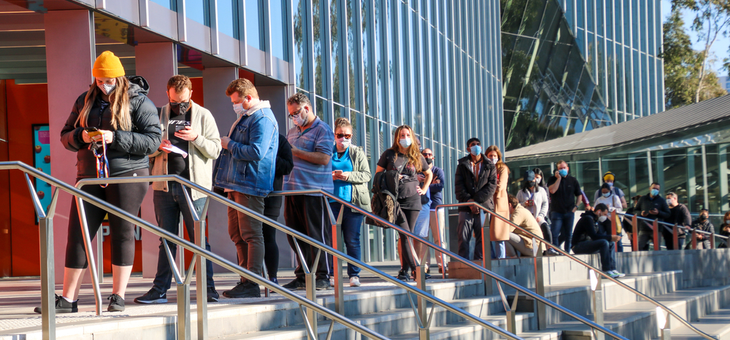Herd immunity is touted as our only way out of the pandemic, but the national vaccine rollout has been patchy at best and today, doctors are slamming the federal government for a lack of transparency around the best and worst vaccinated regions nationwide.
The Age reports figures from the Victorian government showing Gippsland in the state’s south-east as the least vaccinated region per capita at 15 per cent and Albury-Wodonga as the most at 28 per cent.
The figures also reveal that just 27 per cent of vaccines have gone to Melbourne’s western suburbs, one of the worst-hit local government areas during 2020 when more than 900 cases were recorded.
Experts say this is mostly because the lower-income western suburbs of Melbourne have comparatively fewer doctors in the area to administer the vaccine.
Read: Vaccine efficiency against Delta strain revealed
The same level of detail about the situation nationwide has been almost impossible to obtain, The Age reports.
In a move that has fuelled concerns about the lack of transparency surrounding the $7.5 billion vaccine program, federal health minister Greg Hunt is redirecting all queries on a national suburb-by-suburb breakdown of doses administered to the Vaccine Operations Centre, which has so far not released the figures.
The data is seen to be crucial for GPs to ensure that vaccine doses are getting to where they are needed most.
“The whole thrust of the government’s approach is to get us vaccinated, [so] this is absolutely critical information,” says Bill Bowtell, infection control expert and adjunct professor at the University New South Wales.
Increasing the numbers vaccinated against COVID is complicated by distrust in the vaccines themselves and not helped by mounting evidence that people can both catch and transmit COVID even after being vaccinated.
Two doses of the Pfizer vaccine are 88 per cent effective in preventing symptomatic Delta infection, according to a study published in The New England Journal of Medicine. Two doses of AstraZeneca were 67 per cent effective and both were almost 100 per cent effective in preventing death from COVID.
Read: We’re bottom of the (OECD) class in vaccination rates
“The researchers found that fully immunised participants were 25 times less likely to test positive for COVID-19 than those who were unvaccinated,” says immunology expert Professor Sanjay Mishra in an article in The Conversation.
“Findings like this imply that if vaccinated people are so well protected from getting infected at all, they are also unlikely to spread the virus.
“What we know for sure is that if someone does get sick with COVID-19 after vaccination, in what is called a ‘breakthrough infection’, symptoms will be milder,” Prof. Mishra says.
Rather than be a cause for alarm, the Australian Medical Association (AMA) says acquisition and transmission of COVID-19 after vaccination is a normal and expected result.
“A lot of people have misunderstood. There is no vaccine that is 100 per cent effective at stopping transmission,” AMA national vice-president Dr Chris Moy told The New Daily.
Instead, vaccines work by greatly reducing the rate of transmission, the so-called ‘R level’, and Dr Moy says any of the available COVID vaccines will halve this level and eventually halt the virus’s ability to spread.
“We’ve got a Delta with an R level of six. That means every person getting it is giving it to six people,” Dr Moy explains.
“We need to have a manageable amount of transmission, and enough people vaccinated so the consequences of cases will be mitigated.
“It’s important to point out that those people are much less likely to get severely sick. And they’re half as likely to pass it on.”
Read: Why is the Delta variant such a worry?
So you’re far less likely to die, far less likely to get serious symptoms and far less likely to pass COVID on to others. As the percentage of the population that is vaccinated grows, experts say life should begin to return to normal.
“It wouldn’t take a very high proportion [of vaccinated individuals] to make a difference, if we add in other mitigation strategies like high rates of testing, quarantining positive cases, social distancing, and having check-ins at venues,” infectious disease expert Dr Paul Griffin, an associate professor at the University of Queensland, told the ABC.
“If we get some of those basic things right, then even with a modest target achieved, we should be much less reliant on harsher measures like border controls and lockdowns.”
But modelling by the Grattan Institute has shown it will take a vaccination rate of around 80 per cent of the population for Australia to enter its new ‘COVID normal’ and open up safely. With only around 15 per cent of the nation fully vaccinated so far, getting more vaccine supplies into the country and distributed to medical professionals becomes even more vital in the coming months.
“Logistics will be crucial to supercharging the rollout. People should be able to get their jab at mass vaccination hubs, doctors, pharmacies, schools, their workplaces and through pop-up clinics at supermarkets and sporting events,” the Grattan Institute says.
“The 80 per cent threshold could be reached as early as the end of this year if a vaccine becomes available in coming months for children under 12. But if a vaccine is not approved for children under 12, a target date of March next year would be more realistic.”
Are you still concerned about catching COVID even when you’re fully vaccinated? When do you think life will return to some semblance of ‘normal’? Let us know in the comments section below.
If you enjoy our content, don’t keep it to yourself. Share our free eNews with your friends and encourage them to sign up.

